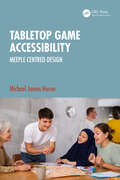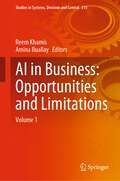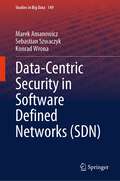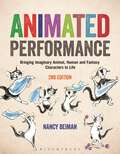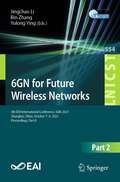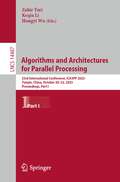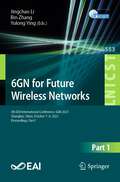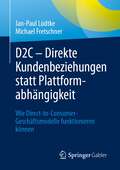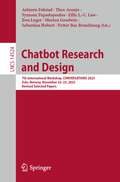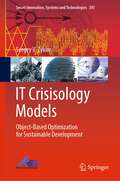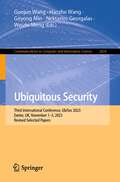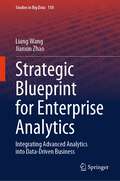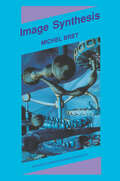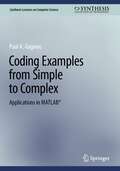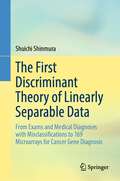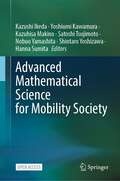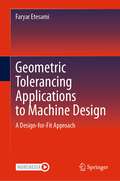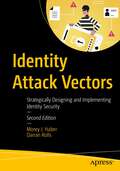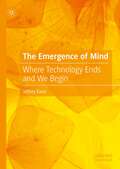- Table View
- List View
Tabletop Game Accessibility: Meeple Centred Design
by Michael James HeronThis foundational resource on the topic of tabletop game accessibility provides actionable guidelines on how to make games accessible for people with disabilities. This book contextualises this practical guidance within a philosophical framework of how the relatively abled can ethically address accessibility issues within game design.This book helps readers to build understanding and empathy across the various categories of accessibility. Chapters on each category introduce ‘the science’, outline the game mechanics and games that show exemplar problems, relate these to the real-world situations that every player may encounter, and then discuss how to create maximally accessible games with reference to the accessibility guidelines and specific games that show ‘best-in-class’ examples of solutions.This book will be of great interest to all professional tabletop and board game designers as well as digital game designers and designers of other physical products.
AI in Business: Volume 1 (Studies in Systems, Decision and Control #515)
by Reem Khamis Amina BuallayThis book is a comprehensive guide to understanding the potential of artificial intelligence (AI) in improving business functions, as well as the limitations and challenges that come with its implementation. In this book, readers will learn about the various opportunities that AI presents in business, including how it can automate routine tasks, reduce errors, and increase efficiency. The book covers a range of topics, including how AI can be used in financial reporting, auditing, fraud detection, and tax preparation. However, the book also explores the limitations of AI in business, such as the need for skilled professionals, data quality, and the potential for bias. It examines the challenges that companies face when implementing AI in business functions, including the need for ethical considerations, transparency, and accountability. The book is written for business professionals, business leaders, and anyone interested in the potential of AI in business functions. It offers practical advice on how to implement AI effectively and provides insights into the latest developments in AI technology. Through case studies and real-world examples, readers will gain a deeper understanding of how AI can be used to enhance business functions, as well as the potential pitfalls and limitations to be aware of. Overall, "AI in Business: Opportunities and Limitations" is an essential guide for anyone looking to harness the power of AI to improve their business functions, and to stay ahead in an increasingly competitive business environment.
Data-Centric Security in Software Defined Networks (Studies in Big Data #149)
by Marek Amanowicz Sebastian Szwaczyk Konrad WronaThe book focuses on applying the data-centric security (DCS) concept and leveraging the unique capabilities of software-defined networks (SDN) to improve the security and resilience of corporate and government information systems used to process critical information and implement business processes requiring special protection. As organisations increasingly rely on information technology, cyber threats to data and infrastructure can significantly affect their operations and adversely impact critical business processes. Appropriate authentication, authorisation, monitoring, and response measures must be implemented within the perimeter of the system to protect against adversaries. However, sophisticated attackers can compromise the perimeter defences and even remain in the system for a prolonged time without the owner being aware of these facts. Therefore, new security paradigms such as Zero Trust and DCS aimto provide defence under the assumption that the boundary protections will be breached. Based on experience and lessons learned from research on the application of DCS to defence systems, the authors present an approach to integrating the DCS concept with SDN. They introduce a risk-aware approach to routing in SDN, enabling defence-in-depth and enhanced security for data in transit. The book describes possible paths for an organisation to transition towards DCS, indicating some open and challenging issues requiring further investigation. To allow interested readers to conduct detailed studies and evaluate the exemplary implementation of DCS over SDN, the text includes a short tutorial on using the emulation environment and links to the websites from which the software can be downloaded.
Animated Performance: Bringing Imaginary Animal, Human and Fantasy Characters to Life (Required Reading Range)
by Nancy BeimanAnimated Performance shows how a character can seemingly 'come to life' when their movements reflect the emotional or narrative context of their situation: when they start to 'perform'.The many tips, examples and exercises from a veteran of the animation industry will help readers harness the flexibility of animation to portray a limitless variety of characters and ensure that no two performances are ever alike. More than 300 color illustrations demonstrate how animal and fantasy characters can live and move without losing their non-human qualities and interviews with Disney animators Art Babbitt, Frank Thomas, Ollie Johnston and Ellen Woodbury make this a unique insight into bringing a whole world of characters to life.New to the second edition: A new chapter with introductory exercises to introduce beginner animators to the the world of animated acting; dozens of new assignments and examples focusing on designing and animating fantasy and animal characters.
6GN for Future Wireless Networks: 6th EAI International Conference, 6GN 2023, Shanghai, China, October 7-8, 2023, Proceedings, Part II (Lecture Notes of the Institute for Computer Sciences, Social Informatics and Telecommunications Engineering #554)
by Jingchao Li Bin Zhang Yulong YingThis 2-volume set constitutes the proceedings of the 6th EAI International Conference on 6GN for Future Wireless Networks, 6GN 2023, held in Shanghai, China, in October 7-8, 2023.The 60 full papers were selected from 151 submissions and present the state of the art and practical applications of 6G technologies. The papers are arranged thematically in tracks as follows: intelligent systems; big data mining, D2D communication, security and privacy for 6G networks; artificial intelligent techniques for 6G networks; power and energy systems I; power and energy system; power and energy systems; image, video, and signal processing; image, video, and signal processing & software engineering; communications systems and networking & control and automation systems; computer systems and applications.
Algorithms and Architectures for Parallel Processing: 23rd International Conference, ICA3PP 2023, Tianjin, China, October 20–22, 2023, Proceedings, Part I (Lecture Notes in Computer Science #14487)
by Zahir Tari Keqiu Li Hongyi WuThe 7-volume set LNCS 14487-14493 constitutes the proceedings of the 23rd International Conference on Algorithms and Architectures for Parallel Processing, ICA3PP 2023, which took place in Tianjin, China, during October 2023.The 145 full papers included in these proceedings were carefully reviewed and selected from 439 submissions. ICA3PP covers many dimensions of parallel algorithms and architectures; encompassing fundamental theoretical approaches; practical experimental projects; and commercial components and systems.
6GN for Future Wireless Networks: 6th EAI International Conference, 6GN 2023, Shanghai, China, October 7-8, 2023, Proceedings, Part I (Lecture Notes of the Institute for Computer Sciences, Social Informatics and Telecommunications Engineering #553)
by Jingchao Li Bin Zhang Yulong YingThis 2-volume set constitutes the proceedings of the 6th EAI International Conference on 6GN for Future Wireless Networks, 6GN 2023, held in Shanghai, China, in October 7-8, 2023. The 60 full papers were selected from 151 submissions and present the state of the art and practical applications of 6G technologies. The papers are arranged thematically in tracks as follows: intelligent systems; big data mining, D2D communication, security and privacy for 6G networks; artificial intelligent techniques for 6G networks; power and energy systems I; power and energy system; power and energy systems; image, video, and signal processing; image, video, and signal processing & software engineering; communications systems and networking & control and automation systems; computer systems and applications.
Basic Immunology and Its Clinical Application (Advances in Experimental Medicine and Biology #1444)
by Mitsuru MatsumotoThis book overviews ongoing and upcoming clinical applications of basic immunology. Recent advances in our knowledge of immunology coupled with new technologies have aided in the development of efficient cancer immunotherapy, as well as the control of emerging microorganisms such as SARS-CoV-2. However, knowledge of basic immunology has not been fully utilized even after the discoveries of immune checkpoint inhibition for cancer immunotherapy and the development of mRNA vaccination against SARS-CoV-2. There is still room for improving the clinical application of basic immunology. The book summarizes the achievements in clinical applications of basic immunology and highlights what can be further extended to make immunology a more practical human science. Basic immunology and its clinical applications are two wheels of the same cart in the immunology field, which aids in the development of more efficient cancer immunotherapy and rapid control of infectious diseases against microorganisms, including new viruses and classical toxoplasmosis. The exploration of ongoing and upcoming applications of basic immunology in this book makes it a useful resource for immunologists, physicians, molecular and genome biologists, bioinformaticians, and students in these fields.
D2C – Direkte Kundenbeziehungen statt Plattformabhängigkeit: Wie Direct-to-Consumer-Geschäftsmodelle funktionieren können
by Jan-Paul Lüdtke Michael FretschnerDieses Buch zeigt kompakt auf, warum es für Unternehmen jeder Größe unumgänglich geworden ist, direkte Beziehungen zu ihren Kunden aufzubauen – nicht zuletzt, weil Plattformen wie Amazon, Google und Meta den Zugang zu Konsumenten oligopolisiert haben. Mit der richtigen Direct-to-Consumer-Strategie (D2C) und einer strukturierten Herangehensweise kann jedes Unternehmen im direkten Kundengeschäft erfolgreich sein, und so wertvolle und nachhaltige Beziehungen zu seiner Zielgruppe aufbauen. Die Autoren führen in die Hintergründe, Strategien und Prozesse ein und beschreiben, wie Unternehmen D2C-Geschäftsmodelle zielführend aufbauen können. Sie erläutern das wichtige Zusammenspiel von Kundenbeziehungen und -daten und geben konkrete Handlungsempfehlungen, welche Hausaufgaben Unternehmen erledigen müssen, um langfristig unabhängig von großen Plattformen zu werden.
Data and the Built Environment: A Practical Guide to Building a Better World Using Data (Digital Innovations in Architecture, Engineering and Construction)
by Ian Gordon Neil ThompsonThis book takes a data-first approach to framing the built environment sector’s unique challenges and how industry can address them through better use of data. It describes how the sector has failed to derive value from data, and the common causes underlying this failure. It then provides practical guidance on how to use data to construct and operate built environment assets in a manner that better meets society’s needs. The book examines how industry norms, organizational culture, and our personal behaviours contribute to the successful use of data. It sets out a philosophy and vision for the use of data in the built environment, and how this in turn might help the sector realise better outcomes in terms of cost, schedule, quality, and sustainability. Data is a valuable asset, one that the built environment sector must generate, protect, manage, and exploit. The book works as a holistic primer to data and the built environment, written both for those who are new to data or the built environment, and including deep-dive material that will provide insight to experienced professionals.
Chatbot Research and Design: 7th International Workshop, CONVERSATIONS 2023, Oslo, Norway, November 22–23, 2023, Revised Selected Papers (Lecture Notes in Computer Science #14524)
by Asbjørn Følstad Theo Araujo Symeon Papadopoulos Effie L.-C. Law Ewa Luger Morten Goodwin Sebastian Hobert Petter Bae BrandtzaegThis book constitutes the proceedings of the 7th International Workshop on Chatbot Research and Design, CONVERSATIONS 2023, which was held during November 2023.The 12 regular papers were carefully reviewed and selected for inclusion in the book. They were organized in following topical sections: Understanding and Enhancing Conversational Interactions, LLM-driven Conversational Design and Analysis, Ethical Perspectives and Bias, Complementing Perspectives.
IT Crisisology Models: Object-Based Optimization for Sustainable Development (Smart Innovation, Systems and Technologies #381)
by Sergey V. ZykovThe book focuses on modeling real-world crisis management in digital product development. This includes models and methods for forecasting, responding, and agile engineering/managing for sustainable product development. This book suggests an approach that contains principles, formal models, and semi-formal practice-oriented methods, patterns and techniques to efficiently manage these crises and provide sustainable development. The book also introduces a set of principles, models, and methods for sustainable management as a blend, the components of which have been carefully selected from a few domains adjacent to digital production such as IT-intensive operation, human resource management, and knowledge engineering, to name a few. The key ingredients of this crisis management framework include smart data modeling, trade-off optimizing, agile product controlling, and knowledge transferring.
Ubiquitous Security: Third International Conference, UbiSec 2023, Exeter, UK, November 1–3, 2023, Revised Selected Papers (Communications in Computer and Information Science #2034)
by Guojun Wang Haozhe Wang Geyong Min Nektarios Georgalas Weizhi MengThis book constitutes the proceedings of the Third International Conference, UbiSec 2023, held in Exeter, UK, during November 1–3, 2023.The 29 full papers were carefully reviewed and selected from 91 submissions. They were organized in following topical sections: Cyberspace Security, Cyberspace Privacy, Cyberspace Anonymity
Strategic Blueprint for Enterprise Analytics: Integrating Advanced Analytics into Data-Driven Business (Studies in Big Data #150)
by Liang Wang Jianxin ZhaoThis book is a comprehensive guide for professionals, leaders, and academics seeking to unlock the power of data and analytics in the modern business landscape. It delves deeply into the strategic, architectural, and managerial aspects of implementing enterprise analytics (EA) systems in large enterprises. The book is meticulously structured into three parts. Part 1 lays the foundation for adaptable architecture in EA. Part 2 explores technical considerations: data, cloud platforms, and AI solutions. The final part focuses on strategy execution, investment, and risk management. Acting as a comprehensive guide, the book enables the creation of robust EA capabilities that foster growth, optimize operations, and keep pace with EA's dynamic world. Whether readers are leaders harnessing data's potential, practitioners navigating analytics, or academics exploring this evolving domain, this book provides insights and knowledge to guide readers toward a thriving, data-driven future.
Image Synthesis
by Michel BretThe images produced by means ofcomputers have invaded our daily lives. One has but to see the "identification logos" of most television broadcasts or some advenisement "spots" to be convinced of this. This proves that the synthesis ofimages has reached maturity. The progress that has been made in the last few years allows one to predict the use ofrealistic illustrations in more and more domains ofapplication. It is thus understandable that more and more people seek to understand how these images are produced. Such a person may be an amateur who likes to understand in a general way the processing involved, or he may be a computer scientist who wants to develop some new application using graphics procedures. This book by Michel Bret meets these desires by giving a complete overview of the techniques of image synthesis by computer. The different stages of the creation of a numerical image are explained in detail, and they are accompanied by descriptions of the most modem methods. Thus thegeometrical models that are described go from those with plane polygonal facets, via surfaces of all types, to systems of panicles. Visualization is treated in complete detail, and due attention is given to all the various roads that lead to a realistic image: simple projections on the basis of wire-frame models, the elimination of hidden pans, and fmally the modelling oflight and its effects.
Coding Examples from Simple to Complex: Applications in MATLAB® (Synthesis Lectures on Computer Science)
by Paul A. GagniucThis book provides a comprehensive guide to Matlab, which stands as the cornerstone of modern education and is the main computer language driving development in science and engineering. The author introduces readers to the rich world of Matlab, taking them on a journey from the fundamentals to advanced topics, equipping them with the knowledge and skills needed to become a proficient Matlab developer or scientist. The book provides a treasure trove of practical examples, meticulously crafted to deepen the reader understanding of Matlab. This comprehensive exploration is designed to cater to novice learners as well as mature developers and scientists, equipping them with the requisite knowledge and competencies to harness the Matlab full potential in their respective projects. From the basics of variable naming and program structure to complex matrix operations, recursion, and object-oriented programming, this book covers it all. This book is part of a series of worksdesigned to present both the examples and their explanations in various computer languages, as close to a mirror version as possible.
The First Discriminant Theory of Linearly Separable Data: From Exams and Medical Diagnoses with Misclassifications to 169 Microarrays for Cancer Gene Diagnosis
by Shuichi ShinmuraThis book deals with the first discriminant theory of linearly separable data (LSD), Theory3, based on the four ordinary LSD of Theory1 and 169 microarrays (LSD) of Theory2. Furthermore, you can quickly analyze the medical data with the misclassified patients which is the true purpose of diagnoses. Author developed RIP (Optimal-linear discriminant function finding the combinatorial optimal solution) as Theory1 in decades ago, that found the minimum misclassifications. RIP discriminated 63 (=26−1) models of Swiss banknote (200*6) and found the minimum LSD: basic gene set (BGS). In Theory2, RIP discriminated Shipp microarray (77*7129) which was LSD and had only 32 nonzero coefficients (first Small Matryoshka; SM1). Because RIP discriminated another 7,097 genes and found SM2, the author developed the Matryoshka feature selection Method 2 (Program 3), that splits microarray into many SMs. Program4 can split microarray into many BGSs. Then, the wide columnLSD (Revolution-0), such as microarray (n Theory3 shows the surprising results of six ordinary data re-analyzed by Theory1 and Theory2 knowledge. Essence of Theory3 is described by using cephalopelvic disproportion (CPD) data. RIP discriminates CPD data (240*19) and finds two misclassifications unique for cesarean and natural-born groups. CPD238 omitting two patients becomes LSD, which is the first case selection method. Program4 finds BGS (14 vars.) the only variable selection method for Theory3. 32 (=25) models, including BGS, become LSD among (219−1) models. Because Program2 confirms BGS has the minimum average error rate, BGS is the most compact and best model satisfying Occam’s Razor. With this book, physicians obtain complete diagnostic results for disease, and engineers can become a true data scientist, by obtaining integral knowledge ofstatistics and mathematical programming with simple programs.
RoboCup 2023: Robot World Cup XXVI (Lecture Notes in Computer Science #14140)
by Cédric Buche Alessandra Rossi Marco Simões Ubbo VisserThis book constitutes the proceedings of the 26th RoboCup International Symposium which was held in Bordeaux, France, during July 4-10, 2023. The 25 regular papers included in these proceedings were carefully reviewed and selected from 47 submissions; the volume also includes 11 RoboCup Champions Papers. In addition to presenting the proceedings of the RoboCup 2023 Symposium, the book highlights the approaches of champion teams from the competitions. Due to the complex research challenges set by the RoboCup initiative, the RoboCup International Symposium offers a unique perspective for exploring scientific and engineering principles underlying advanced robotic and AI systems.
Advanced Mathematical Science for Mobility Society
by Kazushi Ikeda Yoshiumi Kawamura Kazuhisa Makino Satoshi Tsujimoto Nobuo Yamashita Shintaro Yoshizawa Hanna SumitaThis open access book presents the mathematical methods for huge data and network analysis.The automotive industry has made steady progress in technological innovations under the names of Connected Autonomous-Shared-Electric (CASE) and Mobility as a Service (MaaS). Needless to say, mathematics and informatics are important to support such innovations. As the concept of cars and movement itself is diversifying, they are indispensable for grasping the essence of the future mobility society and building the foundation for the next generation. Based on this idea, Research unit named "Advanced Mathematical Science for Mobility Society" was established at Kyoto University as a base for envisioning a future mobility society in collaboration with researchers led by Toyota Motor Corporation and Kyoto University.This book contains three main contents.1. Mathematical models of flow2. Mathematical methodsfor huge data and network analysis3. Algorithm for mobility societyThe first one discusses mathematical models of pedestrian and traffic flow, as they are important for preventing accidents and achieving efficient transportation. The authors mainly focus on global dynamics caused by the interaction of particles. The authors discuss many-body particle systems in terms of geometry and box-ball systems. The second one consists of four chapters and deals with mathematical technologies for handling huge data related to mobility from the viewpoints of machine learning, numerical analysis, and statistical physics, which also includes blockchain techniques. Finally, the authors discuss algorithmic issues on mobility society. By making use of car-sharing service as an example of mobility systems, the authors consider how to construct and analyze algorithms for mobility system from viewpoints of control, optimization, and AI.
Geometric Tolerancing Standard to Machine Design: A Design-for-Fit Approach
by Faryar EtesamiThis book is for students enrolled in undergraduate mechanical engineering, or similar, programs. The material presented is based on nearly thirty years of class-tested lecture notes for courses on the applications of geometric tolerancing for designers. The book’s emphasis is on fit requirements for machine components, as fit assurance makes up the majority of challenging applications in tolerancing. For design engineers, knowing how to apply geometric tolerances has been a challenge even for engineers who have practiced geometric tolerancing for a long time. The syntax and meaning of geometric tolerancing statements can be learned easily and quickly, but knowing how to use them correctly is much more difficult. In the Design-for-Fit approach, the presentation starts with the geometric requirements for various kinds of fit and then presents the geometric tolerance statements necessary to achieve those fits.
Identity Attack Vectors: Strategically Designing and Implementing Identity Security, Second Edition
by Morey J. Haber Darran RollsToday, it’s easier for threat actors to simply log in versus hack in. As cyberattacks continue to increase in volume and sophistication, it’s not a matter of if, but when, your organization will have an incident. Threat actors target accounts, users, and their associated identities—whether human or machine, to initiate or progress their attack. Detecting and defending against these malicious activities should be the basis of all modern cybersecurity initiatives.This book details the risks associated with poor identity security hygiene, the techniques that external and internal threat actors leverage, and the operational best practices that organizations should adopt to protect against identity theft, account compromises, and to develop an effective identity and access security strategy. As a solution to these challenges, Identity Security has emerged as a cornerstone of modern Identity and Access Management (IAM) initiatives. Managing accounts, credentials, roles, entitlements, certifications, and attestation reporting for all identities is now a security and regulatory compliance requirement. In this book, you will discover how inadequate identity and privileged access controls can be exploited to compromise accounts and credentials within an organization. You will understand the modern identity threat landscape and learn how role-based identity assignments, entitlements, and auditing strategies can be used to mitigate the threats across an organization’s entire Identity Fabric. What You Will Learn Understand the concepts behind an identity and how its associated credentials and accounts can be leveraged as an attack vectorImplement an effective identity security strategy to manage identities and accounts based on roles and entitlements, including the most sensitive privileged accountsKnow the role that identity security controls play in the cyber kill chain and how privileges should be managed as a potential weak linkBuild upon industry standards and strategies such as Zero Trust to integrate key identity security technologies into a corporate ecosystemPlan for a successful identity and access security deployment; create an implementation scope and measurable risk reduction; design auditing, discovery, and regulatory reporting; and develop oversight based on real-world strategies to prevent identity attack vectors Who This Book Is For Management and implementers in IT operations, security, and auditing looking to understand and implement an Identity and Access Management (IAM) program and manage privileges in these environments
The Emergence of Mind: Where Technology Ends and We Begin
by Jeffrey KaneWhile it may appear that generative AI has mastered the mystery of the human mind and released its full power, The Emergence of Mind: Where Technology Ends and We Begin demonstrates the profound and fundamental limitations of the technology and its use as a model of human thinking. In response, the book offers an emergent model of the human mind rooted in our experiences as living, sentient, social and conscious beings. The text explores the nature of meaning in human cognition and the critical importance of the experience of ideas. In so doing, it offers insights into the cultivation of specific generative capacities of the human mind.
Proceedings of the Future Technologies Conference (Lecture Notes in Networks and Systems #814)
by Kohei AraiThis book is a collection of thoroughly well-researched studies presented at the Eighth Future Technologies Conference. This annual conference aims to seek submissions from the wide arena of studies like Computing, Communication, Machine Vision, Artificial Intelligence, Ambient Intelligence, Security, and e-Learning. With an impressive 490 paper submissions, FTC emerged as a hybrid event of unparalleled success, where visionary minds explored groundbreaking solutions to the most pressing challenges across diverse fields. These groundbreaking findings open a window for vital conversation on information technologies in our community especially to foster future collaboration with one another. We hope that the readers find this book interesting and inspiring and render their enthusiastic support toward it.
Digital Health: A Primer (Analytics and AI for Healthcare)
by Nilmini WickramasingheHealthcare systems globally are grappling with how best to implement effective and efficient patient-centred care while simultaneously trying to contain runaway costs and provide high quality. This book explores the essential enabling role of digital health, taking a socio-technical perspective and looking at the key facets of technology, people and process in turn.This book examines the opportunities of key digital health components, demystifying digital health and demonstrating how to use its key precepts effectively. The book presents evidence and anecdotes from stakeholders around the world, demonstrating the global relevance and the ability of digital health to uplift and upskill care delivery as it is applied commercially. Bridging academic theory and practice, this is a functional and accessible text for all digital health stakeholders.The text introduces critical issues and is suitable reading for students, practitioners and researchers in digital health and all healthcare-related domains.
Digital Health: A Primer (Analytics and AI for Healthcare)
by Nilmini WickramasingheHealthcare systems globally are grappling with how best to implement effective and efficient patient-centred care while simultaneously trying to contain runaway costs and provide high quality. This book explores the essential enabling role of digital health, taking a socio-technical perspective and looking at the key facets of technology, people and process in turn.This book examines the opportunities of key digital health components, demystifying digital health and demonstrating how to use its key precepts effectively. The book presents evidence and anecdotes from stakeholders around the world, demonstrating the global relevance and the ability of digital health to uplift and upskill care delivery as it is applied commercially. Bridging academic theory and practice, this is a functional and accessible text for all digital health stakeholders.The text introduces critical issues and is suitable reading for students, practitioners and researchers in digital health and all healthcare-related domains.
